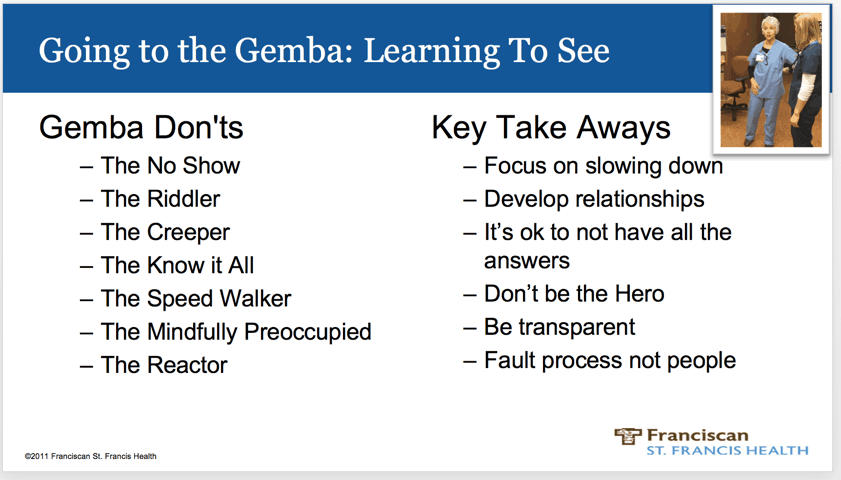This Post in <50 Words: Mischelle McMillin, from Franciscan St. Francis Health, shares “do's and don'ts” for leaders going out to the “gemba” (the workplace). What is “the riddler” and why should you avoid being one in your efforts to create a culture of continuous improvement?

Last spring, Mischelle McMillin spoke at our Kaizen Live! event at Franciscan St. Francis Health (learn more future site visits, which we try to do annually).
She is their Director, Business Transformation, reporting to Joe Swartz within the Franciscan system. Mischelle spoke during the event about Gemba Walks and how they relate to Kaizen and Daily Improvement.
Here is video of this portion of her talk (2016 event attendees have access to the full hour-long talk and Q&A):
During her talk, Mischelle outlined some Gemba “Dos and Don'ts” that she uses to help her organization's leaders during their Gemba experiences.
Mischelle talked about how she and her team pulled together a group of leaders throughout the organization to meet in empty patient rooms each day.
“We stand there for 30 minutes, and we learn to see. We start this journey of creating a culture of going to the Gemba and learning to see,” Mischelle explained.
A few weeks later, with a bit of leading by example by Mischelle's team, further Gemba visits were planned in areas like environmental services, for activities like cleaning patient rooms.
“Some of our front line leaders are really comfortable; some of our other leaders may not be as comfortable so we did give them some Gemba dos and don'ts,” Mischelle said. “So we had lots of dialogue before folks started going out there shadowing and observing.”
These dos and don'ts were developed both for the benefit of the leaders, and the employees who are asked to perform their regular work with a person, who is most likely a stranger, at their hip asking them questions.
The slide she used spelled them out:

Mischelle's Gemba Don'ts include:
The No Show: If you say you're going to be there, you must be there.
The Riddler: To be respectful of the employee who is just trying to get their work done, try to avoid asking a million questions, or rapid-firing questions at them.
The Creeper: Quietly stalking behind someone throughout the day can be uncomfortable for both the employee and the leader doing the Gemba.
The Know it All: Showing staff how to do things while you're at a Gemba should be avoided.
The Speed Walker: Flying into to the Gemba and speeding things along should also be avoided.
The Mindfully Preoccupied: It can be hard when you have a million things to do to complete your own tasks, but while you are at the Gemba you must be present and park everything else on the wayside.
The Reactor: As leaders, we must be conscious of how we're reacting to the things that can happen during a day. Address safety issues if they arise, and don't send mixed messages, but avoid overreacting to things.
“So our leaders began going out, and we just gave them the opportunity to do so, encouraged them, told them how to get scrubs if they didn't have scrubs, and then we began dialoguing about their experiences,” Mischelle explained, “Part of this was really about team and culture and how we were developing that, so as they got through their Gemba experiences, and we kept encouraging them to go back out.”
One morning, the group went to breakfast and Mischelle and her team dug into what the leaders were learning and what their key takeaways were. The leaders identified the following takeaways:
- Focus on slowing down
- Develop relationships
- It's ok not to have all the answers
- Don't be the hero
- Be transparent
- Fault process, not people
A lot of these takeaways were part of the reaction to finding some problems and performance variations on the floor. As leaders with a lot to get done, when an issue is spotted, the tendency is to want to fly in and be the hero, solving the problem and moving on quickly. The leaders soon came to realize that they needed to focus on slowing down and giving room to staff to let them become the problem solvers.
When Mischelle and her team sent the leaders out, they didn't ask them to solve problems, but instead asked them to make connections. Connecting with staff, finding out who their kids are, if they have pets, etc., are so important to the culture of Kaizen, and a true benefit of Gemba.
What do you think of her list? What “dos and don'ts” do you teach or practice at your organization?
Please scroll down (or click) to post a comment. Connect with me on LinkedIn.
If you’re working to build a culture where people feel safe to speak up, solve problems, and improve every day, I’d be glad to help. Let’s talk about how to strengthen Psychological Safety and Continuous Improvement in your organization.








